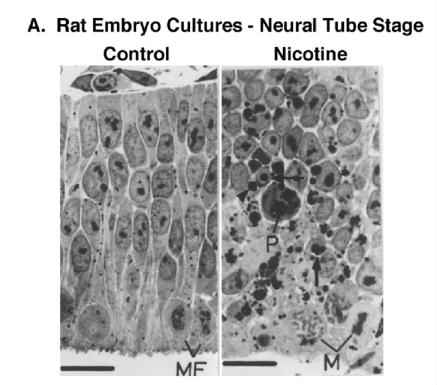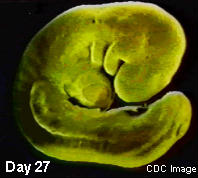
Nicotine damages first trimester embryo
John R. Polito
A rash of recent studies suggest that smoking women with dreams of motherhood would be wise to arrest their chemical dependency now, prior to conception, as new evidence suggests that serious damage to the developing fetus likely begins far earlier than previously thought.
 Professor Theodore A. Slotkin, a Duke Medical University toxicologist, has written a disturbing review of the destructive impact of fetal and adolescent nicotine upon the developing animal brain. Professor Slotkin not only teaches how nicotine hijacks and alters the trajectory of normal brain development, he shares slides of cellular damage inflicted by nicotine in the neural tube stage in rats, the embryotic stage during which the brain first begins to unfold, a stage that starts in human embryos within 3 to 4 weeks of conception.
Professor Theodore A. Slotkin, a Duke Medical University toxicologist, has written a disturbing review of the destructive impact of fetal and adolescent nicotine upon the developing animal brain. Professor Slotkin not only teaches how nicotine hijacks and alters the trajectory of normal brain development, he shares slides of cellular damage inflicted by nicotine in the neural tube stage in rats, the embryotic stage during which the brain first begins to unfold, a stage that starts in human embryos within 3 to 4 weeks of conception.
According to Slotkin's hard hitting study literature review, "the cost of tobacco-related developmental damage includes immediate perinatal events, such as spontaneous abortions, intrauterine growth retardation and perinatal deaths, and Sudden Infant Death Syndrome, but the consequences extend much further, encompassing subsequent learning disabilities, cognitive dysfunction, behavioral problems, attention deficit hyperactivity disorder, psychiatric disorders, conduct disorders, criminal behaviors and school and career failure."
Monday I presented two nicotine cessation seminars at my 25th prison and tomorrow I present three at my 26th, prisons where an average of 60% of inmates were recent slaves to nicotine. I've followed Slotkin's nicotine studies, including a frightening paper publised in Neuropsychopharmacology on how nicotine damages brain serotonin pathways, the neurochemical believed responsible for impulse control. During prison seminars I often find myself speculating on the number of audience inmate faces that would be absent if, at crunch time, the moment prior to their crime, serotonin levels had been adequate and their rational, thinking mind had normal or average control over their impulsive mind.
Published in the current issue of Neurotoxicology and Teratology, Slotkin's latest paper is entitled, "If nicotine is a developmental neurotoxicant in animal studies, dare we recommend nicotine replacement therapy in pregnant women and adolescents?
It has long been known that the nicotine molecule mimics and imitates the neurotransmitter acetylcholine by attaching to and activating certain types of acetylcholine receptors. Slotkin teaches how nicotine disrupts normal brain development by activating acetylcholine receptors prematurely and with inappropriate intensity, before the brain neuron the receptor is attached to has had an opportunity to fully develop and properly interface with surrounding brain neurons.
 According to Slotkin, "excessive stimulation of [acetylcholine receptors] by nicotine produces profound disruption at both cellular and architectural levels," with damage beginning as early as the first trimester of pregnancy.
According to Slotkin, "excessive stimulation of [acetylcholine receptors] by nicotine produces profound disruption at both cellular and architectural levels," with damage beginning as early as the first trimester of pregnancy.
"Fetal nicotine exposure alters the trajectory of neurodevelopment, so that defects continue to emerge over the life span," including "enhanced susceptibility to nicotine dependence and addiction in adolescence."
"It is increasingly clear that brain development extends into adolescence," but "at a lower level of activity than in the fetus or neonate." It is here that acetylcholine receptors in both the rational thinking mind and brain dopamine reward pathways were supposed to mature. But "approximately 3,000 teenagers begin smoking each day, with the majority becoming daily smokers," often with devastating developmental results -- including poor cell signaling -- that is often worse the earlier smoking is initiated.
The adolescent nicotine dependent brain grows or activates (upregulates) the total number of acetylcholine receptors, even more than seen in adult smokers, especially in the midbrain's reward pathways, pathways known to be key to dependency onset, desensitization and tolerance. Slotkin cites studies, including his own, showing how "nicotine remains neurotoxic in the adolescent brain, producing persistent damage with permanent consequences," including both transient and permanent alterations to serotonin pathways.
Culpable Silence
Professor Slotkin expresses deep concern that the medical community has failed to "recognize the magnitude of the problem" or champion effective countermeasures in coming to the defense of healthy and natural fetal and youth development.
 Hollywood continues to partner with the tobacco industry, insisting that teen actor idols smoke in movies, when it knows the consequences. Daily, thousands upon thousands of curious and inquisitive minds explore school or public library magazines such as Popular Science or Popular Mechanics and are assaulted by tobacco ads, ads that selective binding could easily have removed.
Hollywood continues to partner with the tobacco industry, insisting that teen actor idols smoke in movies, when it knows the consequences. Daily, thousands upon thousands of curious and inquisitive minds explore school or public library magazines such as Popular Science or Popular Mechanics and are assaulted by tobacco ads, ads that selective binding could easily have removed.
The tobacco industry has transformed neighborhood convenience stores into nicotine addiction central. Posters promising wonderful flavors, life's greatest and truest pleasures, and stirring of senses, daily assault youth with invitations to smoke nicotine as they pass on school buses, use the store sidewalk, attempt to open the door, when they look up while at candy racks, try to make their purchase or when exiting the store.
 While the First Amendment protects free speech, even commercial speech, it does not protect any public nuisance or any false advertising. Is it an unfair and deceptive trade practice to use advertising to falsely suggest to youth that smokers smoke cigarettes for every reason except the truth, because they must, because a rising tide of anxieties begin to hurt when they don't? Do smokers really smoke because they like smoking or because they don't like what happens when they don't? Is it honest to teach children that smokers smoke for taste when there are zero taste buds inside human lungs?
While the First Amendment protects free speech, even commercial speech, it does not protect any public nuisance or any false advertising. Is it an unfair and deceptive trade practice to use advertising to falsely suggest to youth that smokers smoke cigarettes for every reason except the truth, because they must, because a rising tide of anxieties begin to hurt when they don't? Do smokers really smoke because they like smoking or because they don't like what happens when they don't? Is it honest to teach children that smokers smoke for taste when there are zero taste buds inside human lungs?
Local health and political leaders hold massive hammers, hammers they have so far refused to use. If convenience and grocery stores refuse to end their tobacco ad assault upon children and teens, why not introduce an ordinance requiring that all tobacco products be sold inside stores to which those under age 18 are denied access? If they refuse to act responsibly make them make a choice. They can either have youth or nicotine but not both.
The town or city also has the option of threatening to ban the sale of cigarettes and/or tobacco, as is currently done with alcohol in hundreds of cities and counties across the nation. We are also now seeing cities enact ordinances requiring licenses to sell nicotine, with annual fees based upon store size or gross annual sales, with 100% of fees used to combat youth nicotine dependency onset within the community.
There is no law against any physician, city or activist erecting a sign or painting a building wall so as to teach youth the truth about the amazing power of nicotine to enslave their brain. Canada's mandatory addiction warning label is an excellent reference. It reads, "Warning - Cigarettes are highly addictive - Studies have shown that tobacco can be harder to quit than heroin or cocaine."

How many invitations to smoke nicotine should the adolescent mind be expected to endure before it says, "What the heck, I need to see what all the fuss is about." Is it their fault for eventually growing curious or do physicians, local elected leaders and each of us share responsibility for remaining silent and handing them to the tobacco industry, for enslaving their brains and compelling most to spend the balance of life trying to free themselves from nicotine's powerful grip, a grip likely made quicker if forced to endure nicotine assaults while inside the womb?
Addiction at Birth - Compounding Harms
"The fact that nicotine in the adolescent brain, like the fetal brain, elicits neuronal and synaptic damage, and long-term alterations in synaptic function, means that there is likely to be a biological basis for increased susceptibility to nicotine dependence and long-term, adverse consequences during this late developmental stage. And we must not overlook the fact that the persistent changes are driven by nicotine itself, not other components of tobacco smoke; obviously this argues against the suitability of NRT for smoking cessation in this age group."
What seems to alarm Slotkin most is the fact that fetal nicotine harms, including dependency susceptibility, are compounded by adolescent nicotine damage. As Slotkin puts it, "the interaction of prenatal and adolescent nicotine goes beyond the issue of increased drug intake. At the level of neural cell damage and loss, as well as for persistent deficits in synaptic activity of cholinergic and serotonergic systems, the effects are enhanced by the double treatment."
The combination of fetal and adolescent nicotine appears to destroy protections afforded the female brain, protections the male brain did not enjoy. Where lasting neuro cell damage and behavioral deficits are normally greater in males than females after either prenatal or adolescent nicotine exposure alone, those female protections are lost upon nicotine exposure during both periods.
NRT Use During Pregnancy or Adolescence
In that nicotine is a potent neurotoxicant that adversely effects brain development and synaptic function, Slotkin is troubled by those advocating that expectant mothers or youth use nicotine replacement products (NRT). He argues that prior to making such recommendations proponents should have to prove that doing so is not only both safe and effective, but more effective than quitting without pharmacology.
Slotkin cites studies showing that NRT has not proven effective in either group. One NRT pregnancy study actually had to be discontinued after a 50% increase in adverse birth and neonatal outcomes. In a smaller study, 3 out of 21 infants showed severe neonatal morbidity and in another NRT increased the rate of congenital malformations.
While a number of harm reduction activists continue to falsely portray nicotine as being no more harmful than caffeine, Slotkin points to the fact that, "a number of animal studies of environmental tobacco smoke exposure, both in rodents and primates, point to virtually identical outcomes to those seen with nicotine alone." Those harms include neuronal and synaptic damage, cognitive dysfunction, adverse lung development, immune function and cardiorespiratory function.
Although Slotkin never once challenges the motivations of those advocating NRT use during pregnancy, or by adolescent smokers, it is no secret that many of the most visible and vocal proponents have openly and repeatedly acknowledged financial ties to GlaxoSmithKine or Pfizer, the primary pharmaceutical companies involved in the sale of NRT products.
Nicotine Dependency Recovery
As for successful nicotine cessation during pregnancy or adolescence, Slotkin concludes by noting that instead of turning to interventions that have proven both unsafe and ineffective that "it is mandatory that we focus instead on non-pharmacologic interventions to achieve the important goals of smoking cessation in these groups."
Key to success within both groups is understanding what addiction really means. Amazingly few smokers can explain how the super toxin nicotine is able to enslave brain reward pathways. They need to understand and appreciate the simple beauty of normal dopamine reward pathway function, how these pathways foster species survival by motivating eating, bonding and mating, and how if taken hostage by an external chemical, that high definition memories flowing from them will quickly bury all remaining memory of the beauty of life without nicotine.
They'd benefit by appreciating how the addicted limbic mind now sees smoking nicotine nearly the same as eating food, how thoughts of either tease them with dopamine "aaah" reward sensations, how doing either generate even bigger "aaah sensations, and how if they wait too long prior to eating or smoking that the limbic mind's insulas will punish them with urges, anxieties and full blown craves. What they need to understand is while they cannot live without food, drug addiction is about living a lie as life without nicotine will soon be vastly better than living with it.
We need to help them appreciate that their addicted inner brain has been rewired (upregulation), that their dependency is as permanent as alcoholism, and that the secret to breaking free is in keeping 100% of nicotine out of their bloodstream. When quitting they are not fighting a whole pack or even a whole cigarette but just that one powerful puff of nicotine that would, within 8-10 seconds, cause 40% of their brain's acetylcholine receptors to be occupied, generating a powerful dopamine "aaah" explosion that their mind's pay attention pathways will make nearly impossible, in the short term, to forget. Yes, just one powerful puff of nicotine and their brain will soon be begging for more.
The beauty of admitting that smoking is not just some "nasty little habit" but instead a true chemical addiction -- in seeing ourselves as true drug addicts in every sense -- is that it makes the rules for quitting simple. Like the alcoholic experiencing relapse after just one sip, the mind games are over. It's all or nothing, there is no inbetween. There is no figuring it out, no having our cake and eating it too. It paints a bright line in the sand, a line that on one side says "all" and on the other, "nothing."
Looking in the mirror and seeing a true drug addict looking back destroys the need for the scores of lies our conscious thinking mind invented to explain why we had to obey the endless stream of urges, craves and anxieties flowing from our insulas. It allows us to cast aside false rationalizations such as taste, boredom, flavor, pleasure, like or love. Truth is, we smoked nicotine because we had to, because arriving urges, anxieties and craves would begin to build when we didn't. We didn't smoke because we liked smoking. We smoked because we didn't like what happened when we didn't smoke.
To learn more about nicotine dependency recovery visit and explore WhyQuit. The site is totally free, staffed entirely by volunteers, sells nothing and all offers of donations are declined. There you will learn that coming home to the real you involves just one guiding principle ... no nicotine just one hour, challenge and day at a time, Never Take Another Puff, Dip or Chew!
Related Reading

